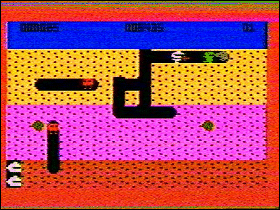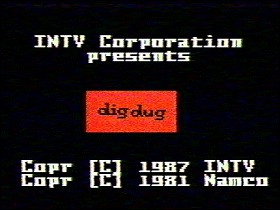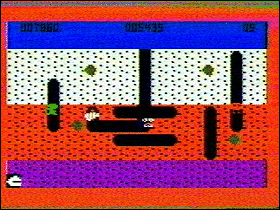 The Game: You are Dig Dug, an intrepid gardener whose soil is infested with pesky Pookas and fire-breathing Fygars. You’re armed with your trusty pump, which you can use to inflate your enemies until, finally, they blow up. But both the Pookas and Fygars can crawl through the ground and can pop out into your tunnels, and if a Fygar sneaks up behind you, he can toast you if you’re not careful. (INTV Corp., 1987)
The Game: You are Dig Dug, an intrepid gardener whose soil is infested with pesky Pookas and fire-breathing Fygars. You’re armed with your trusty pump, which you can use to inflate your enemies until, finally, they blow up. But both the Pookas and Fygars can crawl through the ground and can pop out into your tunnels, and if a Fygar sneaks up behind you, he can toast you if you’re not careful. (INTV Corp., 1987)
Memories: From the ashes of Mattel Electronics, which suffered a multi-million-dollar loss in the 1982-83 crash of the video game industry, several stalwart members of the “Blue Sky Rangers” development team banded together to form INTV Corporation, a leaner, meaner entity that would do what seemed unthinkable in the market climate of the time: keep supporting the Intellivision with new software until further notice. After the NES helped the industry make a comeback, Atari dusted off the 2600 and the stillborn 7800 – which had been ready to hit stores as early as 1984 – and tried to reposition them as budget alternatives to Nintendo’s increasingly ubiquitous machine.
 The problem was, Nintendo was where it was at for a new generation of gamers – the Nintendo name was becoming synonymous with game consoles in exactly the same way that Xerox didn’t want to be synonymous with copiers – and Atari again suffered a black eye after another round with Nintendo. INTV Corp., on the other hand, wasn’t trying to re-introduce an aging hardware platform; it was just trying to keep its existing user base happy with new games, most of which were sold via direct mail catalogs. INTV snagged licenses to Namco’s arcade hits Dig Dug and Pole Position – Atari’s license to both titles having now lapsed – and offered up new versions of each.
The problem was, Nintendo was where it was at for a new generation of gamers – the Nintendo name was becoming synonymous with game consoles in exactly the same way that Xerox didn’t want to be synonymous with copiers – and Atari again suffered a black eye after another round with Nintendo. INTV Corp., on the other hand, wasn’t trying to re-introduce an aging hardware platform; it was just trying to keep its existing user base happy with new games, most of which were sold via direct mail catalogs. INTV snagged licenses to Namco’s arcade hits Dig Dug and Pole Position – Atari’s license to both titles having now lapsed – and offered up new versions of each.
 Dig Dug is the clear winner of the two. Though there are some minor control issues, they’re not game-killers. The game remains intact, and even that jaunty Dig Dug music survives into this version. The levels are subtly different from the arcade game, which can throw off those used to the layout of each level on the coin-op, but that just keeps things interesting. As Dig Dug was sold chiefly by mail order, it’s one of the least common Intellivision games, so it may be hard to come by (and pricey when you do come by it).
Dig Dug is the clear winner of the two. Though there are some minor control issues, they’re not game-killers. The game remains intact, and even that jaunty Dig Dug music survives into this version. The levels are subtly different from the arcade game, which can throw off those used to the layout of each level on the coin-op, but that just keeps things interesting. As Dig Dug was sold chiefly by mail order, it’s one of the least common Intellivision games, so it may be hard to come by (and pricey when you do come by it).
 But for those who, in the late ’80s, stuck by their early ’80s machine, this faithful rendition of an early ’80s favorite must have seemed like an ideal blast from the past.
But for those who, in the late ’80s, stuck by their early ’80s machine, this faithful rendition of an early ’80s favorite must have seemed like an ideal blast from the past.